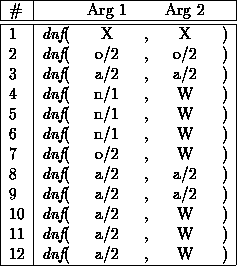In order to show all index features of the compiler, we now want to introduce a larger example and the solutions after each compilation step.
The example is the dnf-procedure![]() which produces the disjunctive normal
form of a logic formula with the operators 'and', 'or' and 'not' (here
written as a, o, and n).
which produces the disjunctive normal
form of a logic formula with the operators 'and', 'or' and 'not' (here
written as a, o, and n).
We begin our example with the RELFUN program of dnf![]() and its head information:
and its head information:
dnf(X, X) :- literal(X).
dnf(o[X, Y], o[X, Y]) :- literal(X), literal(Y).
dnf(a[X, Y], a[X, Y]) :- literal(X), literal(Y).
dnf(n[n[X]], W) :- dnf(X, W).
dnf(n[o[X, Y]], W) :- dnf(a[n[X], n[Y]], W).
dnf(n[a[X, Y]], W) :- dnf(o[n[X], n[Y]], W).
dnf(o[X, Y], W) :- dnf(X, X1), dnf(Y, Y1), norm(o[X1, Y1], W).
dnf(a[X, Y], a[a[X1, X2], Y]) :- literal(Y), dnf(X, a[X1, X2]).
dnf(a[X, Y], a[a[Y1, Y2], X]) :- literal(X), dnf(Y, a[Y1, Y2]).
dnf(a[X, Y], W) :- dnf(X, a[X1, X2]),
dnf(Y, a[Y1, Y2]),
norm(a[a[X1, X2], a[Y1, Y2]], W).
dnf(a[X, Y], W) :- dnf(X, o[X1, X2]),
dnf(Y, Y1),
dnf(o[a[X1, Y1], a[X2, Y1]], W).
dnf(a[X, Y], W) :- dnf(X, X1),
dnf(Y, o[Y1, Y2]),
dnf(o[a[X1, Y1], a[X1, Y2]], W).
Head information:

Classified clauses (indexing part):
(proc
dnf/2
12
(indexing
(sblock
(rblock
(clauses 1 2 3 4 5 6 7
8 9 10 11 12)
(arg
1
(var x)
(struct o 2)
(struct a 2)
(struct n 1)
(struct n 1)
(struct n 1)
(struct o 2)
(struct a 2)
(struct a 2)
(struct a 2)
(struct a 2)
(struct a 2) )
(arg
2
(var x)
(struct o 2)
(struct a 2)
(var w)
(var w)
(var w)
(var w)
(struct a 2)
(struct a 2)
(var w)
(var w)
(var w) ) )
(seqind
(arg
1
(info 3)
(const)
(struct
((o 2)
(clauses 1 2 7)
(sblock
(rblock (clauses 1 2 7)
(arg
2
(var x)
(struct o 2)
(var w)))
(seqind
(arg
2
(info 1)
(const)
(struct ((o 2)
(clauses 1 2 7)))
(list)
(nil)
(other (clauses 1 7))))))
((a 2)
(clauses 1 3 8 9 10 11 12)
(sblock
(rblock
(clauses 1 3 8 9 10 11 12)
(arg
2
(var x)
(struct a 2)
(struct a 2)
(struct a 2)
(var w)
(var w)
(var w) ) )
(seqind
(arg
2
(info 1)
(const)
(struct ((a 2) (clauses 1 3 8 9 10 11 12)))
(list)
(nil)
(other (clauses 1 10 11 12))))))
((n 1)
(clauses 1 4 5 6)
(pblock
(rblock (clauses 1 4 5 6)
(arg
2
(var x)
(var w)
(var w)
(var w)))
(1block (clauses 1) (arg 2 (var x)))
(1block (clauses 4) (arg 2 (var w)))
(1block (clauses 5) (arg 2 (var w)))
(1block (clauses 6) (arg 2 (var w))))))
(list)
(nil)
(other (clauses 1)) )
(arg
2
(info 2)
(const)
(struct
((o 2) (clauses 1 2 4 5 6 7 10 11 12))
((a 2) (clauses 1 3 4 5 6 7 8 9 10 11 12)) )
(list)
(nil)
(other (clauses 1 4 5 6 7 10 11 12)) ) ) ) )
(fun*den ; clauses part omitted
.....
))
The indexing switches had the following values:
indexing on
:min-clauses 2
:max-vars 10
:max-depth 1
:max-args 2
:debug off
In the following we abbreviate the constraints of the type-box in the index tree: c is the constant constraint, str is the structure constraint, l is the list constraint, n is the nil constraint, and the else constraint is the link on the right side of the box (without name).
The index tree corresponding to the index header of the classified dnf/2 clauses is of the following form:
((set_index_number 1)
(switch_on_term 1 "label58" 1 1 "label50")
"label58"
(switch_on_structure
3
(((o 2) "label35") ((a 2) "label42") ((n 1) "label49"))
1 )
"label35"
(set_index_number 2)
(switch_on_term "label36" "label59" "label36" "label36" "label38")
"label59"
(switch_on_structure 1 (((o 2) "label38")) "label36")
"label36"
(try 1 2)
(trust 7 2)
"label38"
(try 1 2)
(retry 2 2)
(trust 7 2)
"label42"
(set_index_number 2)
(switch_on_term "label43" "label60" "label43" "label43" "label45")
"label60"
(switch_on_structure 1 (((a 2) "label45")) "label43")
"label43"
(try 1 2)
(retry 10 2)
(retry 11 2)
(trust 12 2)
"label45"
(try 1 2)
(retry 3 2)
(retry 8 2)
(retry 9 2)
(retry 10 2)
(retry 11 2)
(trust 12 2)
"label49"
(try 1 2)
(retry 4 2)
(retry 5 2)
(trust 6 2)
"label50"
(set_index_number 2)
(switch_on_term "label51" "label61" "label51" "label51" "label57")
"label61"
(switch_on_structure 2 (((o 2) "label53")
((a 2) "label54")) "label51")
"label57"
(try 1 2)
(retry 2 2)
(retry 3 2)
(retry 4 2)
(retry 5 2)
(retry 6 2)
(retry 7 2)
(retry 8 2)
(retry 9 2)
(retry 10 2)
(retry 11 2)
(trust 12 2)
"label53"
(try 1 2)
(retry 2 2)
(retry 4 2)
(retry 5 2)
(retry 6 2)
(retry 7 2)
(retry 10 2)
(retry 11 2)
(trust 12 2)
"label54"
(try 1 2)
(retry 3 2)
(retry 4 2)
(retry 5 2)
(retry 6 2)
(retry 7 2)
(retry 8 2)
(retry 9 2)
(retry 10 2)
(retry 11 2)
(trust 12 2)
"label51"
(try 1 2)
(retry 4 2)
(retry 5 2)
(retry 6 2)
(retry 7 2)
(retry 10 2)
(retry 11 2)
(trust 12 2))
1 ; WAM code for clauses omitted
....
2
....